In trouble? Pick up the phone and call 911. According to the National Emergency Number Association (NENA), 240 million 911 calls are made each year. But if it weren’t for a house fire and a group of angry Brits, the system might not exist today.
Though 911 is an American staple, its origins are in England. In 1935, there was no such thing as an emergency phone number, and phone calls were dependent on operators who connected people to exchanges or emergency services when necessary. England did have emergency fire call points, but they didn’t use telephone technology—instead, they relied on the telegraph, which was used to send a signal to fire departments from special boxes [PDF]. There were police call points, too, but they were generally unstandardized and inefficient, since police didn’t have a way to receive emergency calls while on their beats. Instead, officers would check in during their rounds at special police boxes, like the one you probably recognize from Doctor Who.
But all that changed after November 10, 1935, when a fire broke out at the home of a prominent London surgeon, Philip Franklin, at 27 Wimpole Street. As the blaze tore through the building, five women sleeping on the upper floors—Franklin’s wife and niece, as well as three servants—became trapped. A neighbor, Norman MacDonald, heard their screams and promptly picked up the phone to dial the operator. Nobody answered.
“It seemed entirely futile to continue holding on and listening to ringing tone, which awakened no response,” he later wrote. A neighbor went to a fire call point and firefighters soon arrived, but they were unable to save the five women.

The tragedy sparked a national inquiry—and outrage. Two years later, London unveiled a new service: the emergency number 999. Officials thought it would be best to choose a number that was easy to find by touch on a rotary dial, and rejected a number of other options, like 111, that might be triggered by equipment malfunctions. (It wasn’t unusual for lines rubbing together and other technical glitches to trigger a 111 call; 222 was already in use by a local exchange, while 000 would have just contacted the operator after the first zero.)
The new number wasn’t immediately embraced. Of over 1000 calls made the first week, nearly 7 percent were pranks. And some members of Parliament objected, saying it would be easier to just install an emergency button on phones instead.

The United States had a similar system of police telephones and signal boxes, but like the UK it lacked the technology to quickly and effectively call authorities during emergencies. In the 1950s, the National Association of Fire Chiefs, inspired by the UK’s system, requested a national emergency number, and by 1967 the FTC was meeting with AT&T, the nation’s largest telephone company, to hash out a plan.
The first 911 call in the United States—a test call made from a mayor’s office—was made in Haleyville, Alabama in 1968 [PDF]. The numbers 911 reportedly made the grade because they weren’t in use for any existing phone exchange, and were catchy and easily remembered.
As the service rolled out nationwide, police and fire departments struggled to keep up with call volume. Despite the success of the program, New York police, in particular, reported being strained and having to hire more officers.
It took a long time to implement the system. Only 50 percent of the United States had 911 service as of 1987, according to NENA. Today, coverage is still not universal, although it’s close: 96 percent of the country is currently covered.
The evolution of telephone technology has brought new challenges, however: The FCC estimates that a full 70 percent of calls now come from cell phones—and given the mobility of mobile phones, that’s a challenge for dispatchers and phone companies. The 911 system was built for landlines, and cell phone GPS systems don’t always transmit data quickly or accurately. Plus, the proliferation of cell phones has led to a spike in accidental butt dials, which tie up the line and can prevent real emergencies from getting the attention they need. Still, we've come a long way from the days of sending telegraph messages inside boxes.
